|
Friday, May 9
- Breakfast: blueberry-stuffed French toast
- Breakfast: chorizo and egg burrito
- Tuna melt
- Smart cuisine: white fish florentine
- Kielbasa and kraut
- Eggplant parmesan panino
- Cilantro lime chicken bowl
- Clam chowder
- Texas-style chili
- Assorted pizza by the slice
Wilson Hall Cafe menu
|
|
Friday, May 9
Dinner
- Mussels with white wine and thyme
- Herb-crusted lamb chops
- Caramelized onion and horseradish mashed potatoes
- Sauteed baby carrots
- Banana profiteroles
Wednesday, May 14
Lunch
- Danish open-face sandwiches
- Cucumber salad
- Caramel apple cake
Chez Leon menu
Call x3524 to make your reservation.
|
|
Three Fermilab-affiliated researchers receive prestigious DOE awards
The Department of Energy has selected two Fermilab researchers and one user working on Fermilab experiments to receive the DOE Early Career Research Award, a prestigious financial award given to the most promising researchers in the early stages of their careers.
This year, 35 researchers were selected from a pool of about 750 university- and national laboratory-based applicants. Among the recipients were:
- Eric Dahl, joint Fermilab-Northwestern University physicist: "A Scintillating Xenon Bubble Chamber for Dark Matter Detection"
- Anna Grassellino, Fermilab physicist: "Impurity Doping of Niobium for Ultra-Efficient Superconducting RF Cavities"
- James Hirschauer, Fermilab physicist: "Search for New Phenomena at the 13 TeV LHC: Fast Start and Strong Finish"
The five-year awards are "designed to bolster the nation's scientific workforce by providing support to exceptional researchers during the crucial early years, when many scientists do their most formative work."
The funding received through the awards will be used by recipients to carry out the research detailed in their respective proposals.
Profiles on these three individuals and their research will run in Fermilab Today in the next few weeks.
|
Fermilab Users Meeting registration now open
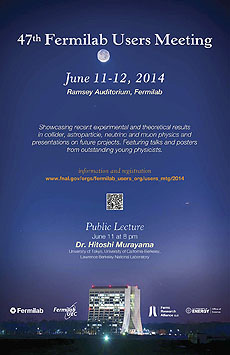 |
The 2014 Fermilab Users Meeting takes place from June 11-12. Registration is now open. |
Registration for the 47th annual Fermilab Users Meeting is now open. The meeting will take place from June 11-12.
Topics to be covered at the Users Meeting include collider physics, astroparticle physics, neutrino physics, muon physics and future plans. The Users Meeting program includes a summary of the P5 report by P5 chair Steve Ritz, a report by HEPAP chair Andrew Lankford and a panel discussion about the P5 report with ample time for questions from Fermilab users.
The New Perspectives conference, organized by the Fermilab Student and Postdoc Association, will be held before the Users Meeting, from June 9-10. Its poster session will take place during the Users Meeting banquet on the evening of June 11.
This year's meeting features a special tribute to Fermilab scientist Alvin Tollestrup to celebrate his extraordinary career.
The meeting will also feature a public lecture on June 11 by Hitoshi Murayama of the University of Tokyo, the University of California, Berkeley and Lawrence Berkeley National Laboratory.
The deadline for registration is June 4. For more information, visit the Users Meeting Web page. You can also view the draft meeting agenda.
|
May 11, 1974: Fermilab dedication
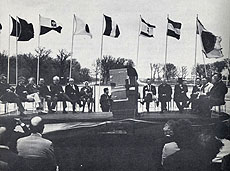 |
| Fermilab personnel, users and visitors gather in front of the newly completed central laboratory building (later named Wilson Hall) to celebrate the dedication of the lab. On the platform, from left: John Erlewine, Leon M. Lederman, Dixy Lee Ray, Representative Craig Hosmer, Norman Ramsey, Representative Melvin Price, Laura Fermi, Robert Bacher (standing), Senator Charles Percy, Geoffrey Norman, Representative Chet Holifield, Robert R. Wilson, Representative Frank Annunzio (obscured), Guyford Stever, Gerald Tape (partially obscured), John Teem Photo: Fermilab |
On a windy day 40 years ago this Sunday, Atomic Energy Commission (AEC) Chair Dixy Lee Ray dedicated the National Accelerator Laboratory, which was founded seven years earlier, as the Fermi National Accelerator Laboratory. In 1969, the AEC had announced its decision to name the lab in honor of Nobel Prize-winning Italian physicist Enrico Fermi, famous for producing the world's first controlled, self-sustaining nuclear chain reaction at the University of Chicago.
More than 1,500 people attended the dedication, including several congressmen, former Universities Research Association President Norman F. Ramsey and H. Guyford Stever, the science advisor to the president. Speakers at the ceremony included Ray, Senator Charles Percy, Joint Committee on Atomic Energy Chair Melvin Price, URA President Robert Bacher, Laura Fermi (Enrico Fermi's widow), lab Director Robert R. Wilson and Users Committee Chair and future lab director Leon M. Lederman.
During his remarks, Wilson said, "We are deeply honored to have the name of Fermi attached to our laboratory. Laura, I pledge in your name that we will do our best to make this a laboratory worthy of the name of Enrico Fermi."
A plaque at the entrance of Wilson Hall states that President Richard Nixon and previous AEC Chair James Schlesinger dedicated Fermilab. Even though Nixon sent a letter for the dedication that Stever read aloud at the ceremony, he and Schlesinger never visited Fermilab. Watch these pages for news of a corrected plaque marking this significant moment in Fermilab's history.
The program from the dedication, the text of the remarks given by the speakers, a copy of the original AEC press release announcing the naming, and many other materials related to the dedication are available in the Fermilab Archives.
You can read about the event in the May 9, 1974, and May 16, 1974, issues of the original Fermilab employee newsletter, The Village Crier. You can also see the program and read more about the dedication ceremony at the Fermilab History and Archives Project website.
—from the Fermilab History and Archives Project
|
Why astronomers think dark matter exists
From The Economist, April 30, 2014
Astronomy is the most awe-inspiring of the sciences. To look up on a truly dark night, away from the light pollution of civilisation, is to be struck by the sheer amount of stuff that makes up creation. But modern astronomy teaches that the stuff that can be seen with the naked eye isn't even the half of it. The matter that can be seen spread across the sky as planets, comets, stars, nebulae, galaxies and the rest makes up just under 15% of the total. Astronomers have dubbed the remaining 85% "dark matter", because it neither absorbs nor gives off light. Although they are pretty sure it is real, they know nothing about it directly. How can scientists be so sure that something that is invisible is nevertheless there?
Read more
|
|
Times have really changed
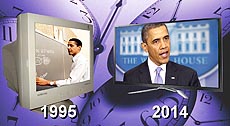 |
| In the two decades that have passed since the discovery of the top quark, many things have changed, including the top quark's transition from newly discovered to well-studied particle.
|
I remember the day in 1995 when the discovery of the top quark was announced at Fermilab. There were reporters. There was champagne. There was a raucous party. It was a big deal, the likes of which are seen once every decade or two.
At the time, the top quark discovery was not seen as just another study of the strong force. But for all the buzz, that's really what it was. A quark and antiquark fused to make a gluon, which then converted into a top quark-antiquark pair. At some level, the physics was pretty mundane. (Of course, this didn't stop us celebrating the discovery!)
The reason the top quark was so hard to find at Fermilab was that its mass is so big; it was hard to make with the Tevatron of the early 1990s. At the Large Hadron Collider, which came online in 2008, things are different. The LHC has higher energy — high enough that making top quarks is now relatively common. In CMS, top quarks are produced at a rate of about one per second.
Quantum chromodynamics, which scientists have been studying since the 1970s, is the theory of the strong force, and it governs the behavior of quarks and gluons. Scientists would like to know whether this well-studied QCD theory correctly predicts what is seen in top quark production, just as it does for other, lighter quarks.
QCD predicts that, in addition to the "main event" in which a top quark-antiquark pair is made, other quarks and gluons are also produced. It's kind of like when you slap your hand hard down into water. There's all the main activity where your hand hits the surface, but there are also stray drops of water that fly around. QCD should be able to predict on average how many extra "drops" of quarks and gluons are produced.
This measurement goes beyond simply testing QCD. Many new physics theories predict that events in which top quarks are produced might be a good place to look for, for instance, events with Higgs bosons or that reveal supersymmetry.
CMS scientists took a couple of data samples containing more than 100,000 top quarks and quantified the presence or absence of other quarks and gluons. The data was in very good agreement with the predictions of QCD, which means there was no big discovery. Nevertheless, the data verified that QCD is a good theory of top quark production, so we can be that much more confident about any future discoveries that hinge on the presence of top quarks.
It is often said in particle physics that yesterday's discovery is today's calibration point and tomorrow's annoying background. For those of us who were part of the top quark discovery, we can but shake our heads. It's hard to imagine that the top quark has so quickly become yet another tool to explore our universe. And yet it has. That's a good thing.
—Don Lincoln
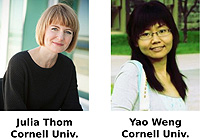 |
| These U.S. scientists contributed to this analysis in collaboration with scientists from CERN and Karlsruhe Institute of Technology.
|
 |
| Members of the Fermilab Experiments Facilities Department of the Scientific Computing Division provide support for the Linux consoles used in the CMS Remote Operations Center on the first floor of Wilson Hall at Fermilab.
|
|
MINERvA's new window on an old interaction
 |
| What does the proton say? Tammy Walton will discuss MINERvA's latest result at today's wine and cheese seminar.
|
Fermilab postdoc Tammy Walton, formerly of Hampton University, will present a new measurement from the MINERvA experiment, "Exclusive Muon and Proton Quasileastic-like Scattering," at the Joint Experimental-Theoretical Physics Seminar today at 4 p.m. in One West.
Quasielastic scattering is one of the most important interactions in neutrino physics these days. For a muon neutrino interaction, both a muon and one or more protons are produced. MINERvA originally studied the quasielastic interaction by measuring everything it could about the outgoing muon. Today Walton will present measurements of the same interaction but by measuring everything it can about the outgoing proton.
Stay tuned for next week's Frontier Result of the Week for more details, or see the whole story at today's seminar.
|
Bald eagle by Wilson Hall
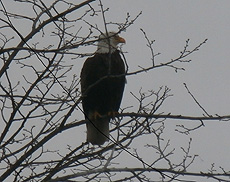 |
| Drue Wallace, AD, spotted this eagle looking out over the pond in front of Wilson Hall. Luckily, a co-worker was nearby to snap the photo. Photo: Jamie Clemons, AD
|
|
No outside horse riders
In Thursday's Photo of the Day, we incorrectly stated that those outside the laboratory may take their horses on site for riding. The public is not permitted to bring horses on site. This activity was suspended beginning last year. The caption in Thursday's issue is now corrected. Fermilab Today regrets the error.
|
|